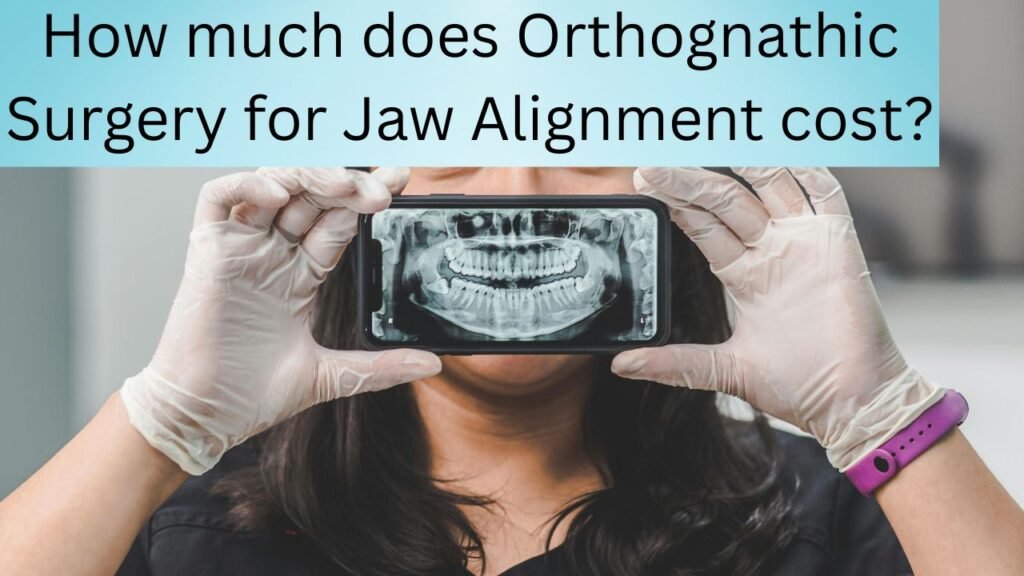If you’re exploring options to correct a jaw misalignment, you’ve likely found yourself wondering:
How much does orthognathic surgery for jaw alignment cost in the USA?
It’s one of the most common — and important — questions patients ask when thinking about this life-changing procedure. The truth is, jaw surgery isn’t cheap, but understanding what you’re paying for (and why) can make the process a whole lot easier.

Let’s break it all down in the clearest way possible. Here’s what you need to know:
💰 What’s the Real Cost of Orthognathic Surgery in the USA?
The average cost of orthognathic surgery in the United States falls between $20,000 to $50,000 or more, depending on several factors. These include the complexity of the case, whether you need surgery on one or both jaws, and how much is covered by your insurance.
🧾 Quick Cost Breakdown
| Surgery Type | Average Cost Range | What’s Included |
|---|---|---|
| Single Jaw Surgery | $20,000 – $30,000 | Surgeon, hospital stay, anesthesia, diagnostics |
| Double Jaw Surgery | $35,000 – $50,000+ | Upper & lower jaw, added surgical complexity |
| With Complications or Extras | $50,000 – $80,000 | Sleep apnea correction, bone grafts, ICU care |
💡 Most patients don’t need ICU-level care or advanced reconstruction, but when they do, the cost increases significantly.
🤔 Why Does Orthognathic Surgery Cost So Much?
This surgery is not just cosmetic—it’s a functional correction that involves the jawbones, facial nerves, muscles, and dental alignment. Several factors influence the total cost, including:
1. Surgeon’s Experience
- Highly experienced oral & maxillofacial surgeons charge more — and for good reason.
- They handle complex anatomical cases, and outcomes are often better with experienced specialists.
2. Geographic Location
- Surgeries in cities like New York, Los Angeles, or Chicago tend to be more expensive due to higher hospital and facility fees.
- Rural areas might offer lower pricing, but may lack access to advanced surgical teams.
3. Hospital & Facility Fees
- These cover operating room time, overnight stays, and recovery facilities.
- The more complex your case (e.g., airway involvement, overnight monitoring), the higher the facility costs.
4. Pre-Surgical Orthodontics
- Orthodontic work is usually required before and after surgery.
- This can add $3,000–$7,000 or more to the total treatment plan.
5. Diagnostic Imaging & Surgical Planning
- CT scans, 3D jaw modeling, and digital occlusion mapping are necessary tools.
- These advanced diagnostics usually add $1,000–$2,500 to the process.
🧾 Insurance Coverage for Orthognathic Surgery: What You Need to Know
So, does insurance cover jaw surgery?
Sometimes — but it’s tricky.
Many private insurance companies will only cover orthognathic surgery if it’s deemed medically necessary (not cosmetic). That means your case must involve:
- Sleep apnea
- Chewing or speaking difficulties
- Facial trauma or congenital jaw deformities
Even then, you’ll need to:
- Submit detailed documentation
- Get pre-authorization
- Possibly go through appeals if initially denied
⚠️ Watch out for exclusions — some policies exclude jaw surgery entirely, regardless of medical need. It’s critical to read the fine print or speak directly with a representative.
💳 Can’t Afford It Upfront? Here’s How to Finance Jaw Surgery
Not everyone can pay tens of thousands out of pocket. Luckily, there are financing options that can make orthognathic surgery more accessible.
✅ Financing Options:
- Healthcare Credit Cards (CareCredit, Alphaeon)
- 0% interest promotional periods
- Good for people with strong credit
- Personal Medical Loans
- Offered by lenders like LightStream or LendingClub
- Interest rates from 6% to 20%, based on credit score
- Monthly payments spread over 2–5 years
- In-House Financing from Oral Surgeons
- Some clinics offer payment plans or financing partners
- May require a deposit or co-signer
🧠 Tip: Always check loan origination fees, early payoff penalties, and monthly repayment estimates before signing anything.
🧠 The Long-Term Value: Is It Worth the Price?
Absolutely — when medically necessary, orthognathic surgery improves more than your smile.
Here’s why it’s a smart long-term investment:
- Reduces chronic jaw pain, TMJ issues, and uneven tooth wear
- Improves airway function (can treat sleep apnea without a CPAP)
- Avoids costly future dental problems caused by misalignment
- Enhances self-confidence and facial symmetry
💬 “Before surgery, I couldn’t chew without discomfort. Now I can eat, speak, and smile without pain — it was worth every penny.”
– Real patient story
📅 Take the Next Step: How to Find Out Your Cost
Every patient is different. That’s why the most accurate way to know how much orthognathic surgery for jaw alignment costs in your case is to schedule a personal consultation.
A board-certified oral & maxillofacial surgeon will evaluate your bite, imaging, and medical history, and give you a custom treatment plan and cost estimate.
conclusion:
Correcting jaw alignment isn’t just about looks. It’s about fixing how your mouth works, how you breathe, chew, speak, and live day to day.
Yes, it’s a big investment. But it’s also a life-changing medical procedure that can transform your quality of life and prevent lifelong issues.
- How much does orthognathic surgery cost? In the USA, $20,000–$50,000+ depending on complexity.
- Factors like surgeon experience, hospital fees, and location impact your cost.
- Insurance may help — if surgery is medically necessary.
- Financing options like healthcare loans or credit cards can ease the burden.
- Long-term value includes functional, health, and emotional benefits.
Find Your Perfect Dentist
Book appointments with top-rated dentists in your area